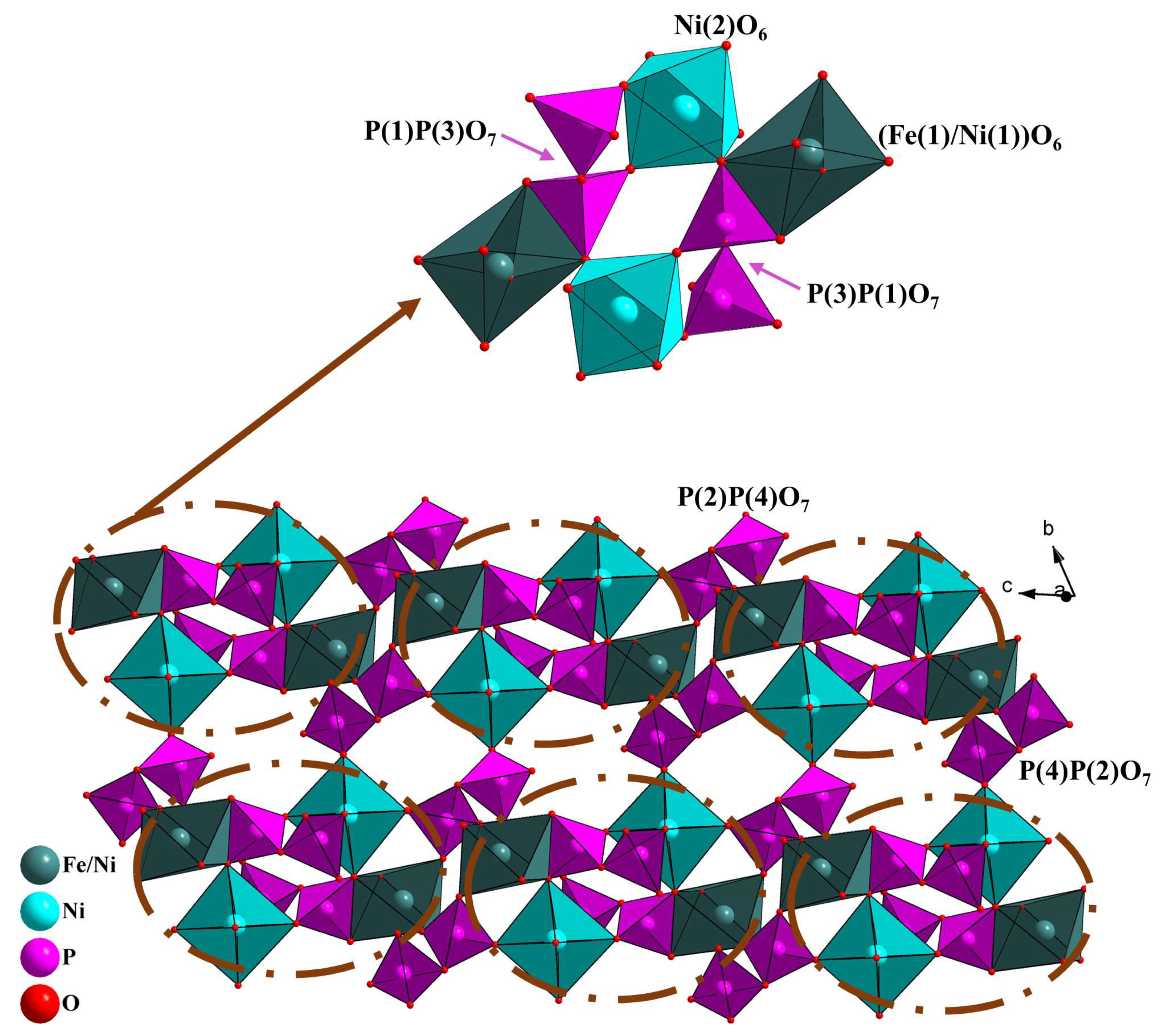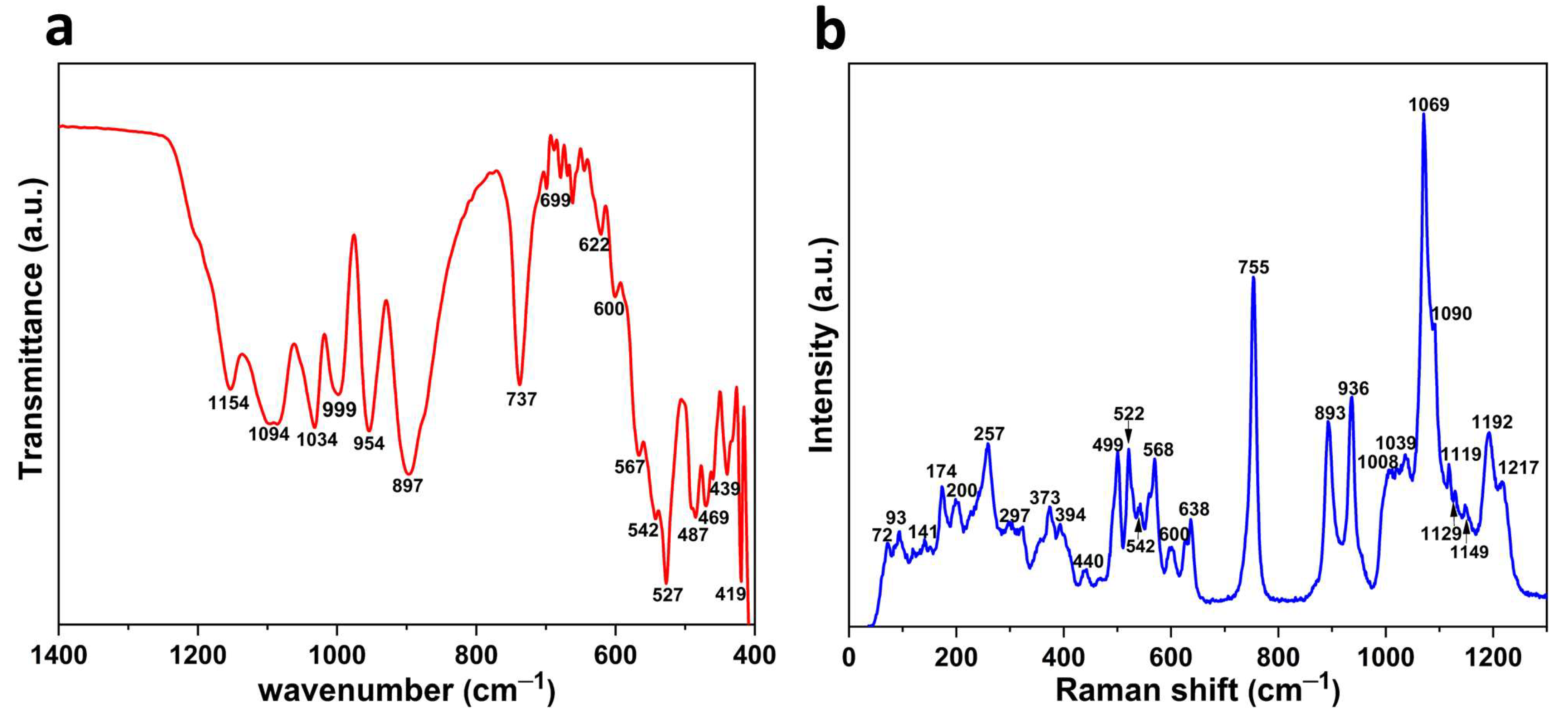Structural and Magnetic Investigations of the Novel Pyrophosphate Na7Ni3Fe(P2O7)4
Abstract
:1. Introduction
2. Materials and Methods
2.1. Synthesis
2.2. Characterizations
3. Results and Discussion
3.1. Crystal Structure
3.2. Powder X-ray Diffraction and Scanning Electron Microscopy
3.3. FT-Infrared and Raman Spectroscopy
3.4. Magnetic Behavior
4. Conclusions
Supplementary Materials
Author Contributions
Funding
Institutional Review Board Statement
Informed Consent Statement
Data Availability Statement
Acknowledgments
Conflicts of Interest
References
- Gopalakrishnan, J.; Rangan, K.K.; Prasad, B.R.; Subramanian, C.K. New Transition Metal Phosphates Related to KTiOPO4. Synthesis of K0.5M0.5M′0.5OPO4 (M = Nb, Ta; M′ = Ti, V) and K1−xTi1−xVxOPO4 Exhibiting Nonlinear Optical Behavior. J. Solid State Chem. 1994, 111, 41–47. [Google Scholar] [CrossRef]
- Dai, D.; Whangbo, M.-H.; Koo, H.-J.; Rocquefelte, X.; Jobic, S.; Villesuzanne, A. Analysis of the Spin Exchange Interactions and the Ordered Magnetic Structures of Lithium Transition Metal Phosphates LiMPO4 (M = Mn, Fe, Co, Ni) with the Olivine Structure. Inorg. Chem. 2005, 44, 2407–2413. [Google Scholar] [CrossRef] [PubMed]
- García-Moreno, O.; Alvarez-Vega, M.; García-Alvarado, F.; García-Jaca, J.; Gallardo-Amores, J.M.; Sanjuán, M.L.; Amador, U. Influence of the Structure on the Electrochemical Performance of Lithium Transition Metal Phosphates as Cathodic Materials in Rechargeable Lithium Batteries: A New High-Pressure Form of LiMPO4 (M = Fe and Ni). Chem. Mater. 2001, 13, 1570–1576. [Google Scholar] [CrossRef]
- Chen, S.; Wu, C.; Shen, L.; Zhu, C.; Huang, Y.; Xi, K.; Maier, J.; Yu, Y. Challenges and Perspectives for NASICON-Type Electrode Materials for Advanced Sodium-Ion Batteries. Adv. Mater. 2017, 29, 1700431. [Google Scholar] [CrossRef] [PubMed]
- Yang, F.; Wang, L.; Huang, L.; Zou, G. The study of structure evolvement of KTiOPO4 family and their nonlinear optical properties. Coord. Chem. Rev. 2020, 423, 213491. [Google Scholar] [CrossRef]
- Gong, C.; Xue, Z.; Wen, S.; Ye, Y.; Xie, X. Advanced carbon materials/olivine LiFePO4 composites cathode for lithium ion batteries. J. Power Sources 2016, 318, 93–112. [Google Scholar] [CrossRef]
- Wang, Y.; Pan, S.; Yu, H.; Su, X.; Zhang, M.; Zhang, F.; Han, J. Cs4Mo5P2O22: A first Strandberg-type POM with 1D straight chains of polymerized [Mo5P2O23] 6−Units and moderate second harmonic generation response. Chem. Commun. 2013, 49, 306–308. [Google Scholar] [CrossRef]
- Gezović, A.; Vujković, M.J.; Milović, M.; Grudić, V.; Dominko, R.; Mentus, S. Recent developments of Na4M3(PO4)2(P2O7) as the cathode material for alkaline-ion rechargeable batteries: Challenges and outlook. Energy Storage Mater. 2021, 37, 243–273. [Google Scholar] [CrossRef]
- Arbi, K.; Hassen-Chehimi, D.B.; Trabelsi-Ayadi, M.; Silvestre, J. Structure refinement of potassium–samarium cyclotetraphosphate KSmP4O12. Mater. Res. Bull. 2000, 35, 1533–1539. [Google Scholar] [CrossRef]
- Barpanda, P.; Nishimura, S.I.; Yamada, A. High-Voltage Pyrophosphate Cathodes. Adv. Energy Mater. 2012, 2, 841–859. [Google Scholar] [CrossRef]
- Polnišer, R.; Štolcová, M.; Hronec, M.; Mikula, M. Structure and reactivity of copper iron pyrophosphate catalysts for selective oxidation of methane to formaldehyde and methanol. Appl. Catal. A Gen. 2011, 400, 122–130. [Google Scholar] [CrossRef]
- Villain, S. Ionic conductivity of pure sodium pyrophosphate Na4P2O7. Solid State Ion. 1999, 116, 73–83. [Google Scholar] [CrossRef]
- Béjaoui, A.; Horchani-Naifer, K.; Hajji, M.; Férid, M. Crystal structure, physical properties and bond valence analysis of NaLuP2O7. Solid State Sci. 2014, 31, 46–53. [Google Scholar] [CrossRef]
- Li, S.; Li, Y.; Xu, N.; Li, S.; Zhong, N.; Fu, C.; Luo, H.; Wang, H. Novel ZrP2O7 ceramic foams with controllable structures and ultra-low thermal conductivity. J. Eur. Ceram. Soc. 2021, 41, 7233–7240. [Google Scholar] [CrossRef]
- Zhao, Z.; Xiang, H.; Dai, F.-Z.; Peng, Z.; Zhou, Y. (TiZrHf)P2O7: An equimolar multicomponent or high entropy ceramic with good thermal stability and low thermal conductivity. J. Mater. Sci. Technol. 2019, 35, 2227–2231. [Google Scholar] [CrossRef]
- Niu, Y.; Zhang, Y.; Xu, M. A review on pyrophosphate framework cathode materials for sodium-ion batteries. J. Mater. Chem. A 2019, 7, 15006–15025. [Google Scholar] [CrossRef]
- Gentil, S.; Andreica, D.; Lujan, M.; Rivera, J.-P.; Kubel, F.; Schmid, H. Synthesis, structure and magnetic susceptibility of KCrP2O7, a potential antiferromagnetic magnetoelectric. Ferroelectrics 1997, 204, 35–44. [Google Scholar] [CrossRef] [Green Version]
- Adam, L.; Pautrat, A.; Perez, O.; Boullay, P. Contrasted role of disorder for magnetic properties in an original mixed-valency iron phosphate. Phys. Rev. B 2010, 82, 054401. [Google Scholar] [CrossRef] [Green Version]
- Natarajan, S.; Mandal, S. Open-framework structures of transition-metal compounds. Angew. Chem.-Int. Ed. 2008, 47, 4798–4828. [Google Scholar] [CrossRef]
- Shvanskaya, L.V.; Volkova, O.S.; Vasiliev, A.N. A review on crystal structure and properties of 3d transition metal (II) orthophosphates M3(PO4)2. J. Alloys Compd. 2020, 835, 155028. [Google Scholar] [CrossRef]
- Bruker-Nonius, SAINT-Plus, version 7.06a; Bruker AXS Inc.: Madison, WI, USA, 2004.
- Sheldrick, G.M. SADABS Version 2004/1; A Program for Empirical Absorption Correction; University of Göttingen: Göttingen, Germany, 2004. [Google Scholar]
- Sheldrick, G.M. SHELXT—Integrated space-group and crystal-structure determination. Acta Crystallogr. Sect. A Found. Adv. 2015, 71, 3–8. [Google Scholar] [CrossRef] [Green Version]
- Sheldrick, G.M. Crystal structure refinement with SHELXL. Acta Crystallogr. Sect. C Struct. Chem. 2015, 71, 3–8. [Google Scholar] [CrossRef] [Green Version]
- Farrugia, L.J. WinGX and ORTEP for Windows: An update. J. Appl. Crystallogr. 2012, 45, 849–854. [Google Scholar] [CrossRef]
- Putz, H. Diamond-crystal and molecular structure visualization crystal impact. Rathausgasse 2014, 30, 1997–2000. [Google Scholar]
- Rodríguez-Carvajal, J. Magnetic structure determination from powder diffraction using the program Fullprof. In Applied Crystallography; World Scientific: Singapore, 2001; pp. 30–36. [Google Scholar] [CrossRef]
- Erragh, F.; Boukhari, A.; Abraham, F.; Elouadi, B. Study of the Crystal Structures of Sodium Magnesium and Sodium Nickel Diphosphates. J. Solid State Chem. 2000, 152, 323–331. [Google Scholar] [CrossRef]
- Ma, R.; Yang, Y.; Pan, S.; Sun, Y.; Yang, Z. Structure comparison and optical properties of Na7Mg4.5(P2O7)4: A sodium magnesium phosphate with isolated P2O7 units. New J. Chem. 2017, 41, 3399–3404. [Google Scholar] [CrossRef]
- Marzouki, R.; Guesmi, A.; Zid, M.F.; Driss, A. Synthesis, Crystal Structure and Electrical Properties of a New Mixed Compound (Na0.71Ag0.29)2CoP2O7. Cryst. Struct. Theory Appl. 2012, 01, 68–73. [Google Scholar] [CrossRef] [Green Version]
- Chen, M.; Chen, L.; Hu, Z.; Liu, Q.; Zhang, B.; Hu, Y.; Gu, Q.; Wang, J.; Wang, L.; Guo, X.; et al. Carbon-Coated Na3.32Fe2.34 (P2O7)2 Cathode Material for High-Rate and Long-Life Sodium-Ion Batteries. Adv. Mater. 2017, 29, 1605535. [Google Scholar] [CrossRef]
- Moussa, M.A.B. Synthesis and Structure of New Mixed Silver Cobalt(II)/(III) Diphosphate–Ag3.68Co2(P2O7)2. Silver(I) Transport in the Crystal. Int. J. Electrochem. Sci. 2019, 14, 1500–1515. [Google Scholar] [CrossRef]
- Angenault, J.; Couturier, J.-C.; Quarton, M.; Robert, F. Structure of Na3.12Fe2.44(P2O7)2. Eur. J. Solid State Inorg. Chem. 1995, 32, 335–343. [Google Scholar]
- Materials Data on Na2CoP2O7 by Materials Project. 2016. Available online: https://www.osti.gov/dataexplorer/servlets/purl/1328091 (accessed on 15 June 2023).
- Rietveld, H.M. A profile refinement method for nuclear and magnetic structures. J. Appl. Crystallogr. 1969, 2, 65–71. [Google Scholar] [CrossRef]
- Klug, H.P.; Alexander, L.E. X-ray Diffraction Procedures: For Polycrystalline and Amorphous Materials, 2nd ed.; Wiley: Hoboken, NJ, USA, 1974. [Google Scholar]
- Lamsaf, H.; Fausto, R.; Costa, B.F.O.; Toyir, J.; Elghadraoui, E.H.; Ijjaali, M.; Oulmekki, A. Synthesis and physicochemical characterization of a new mixed-valence IronIII-ZincII diphosphate: Zn2+Fe3+2(P2O7)2. Mater. Chem. Phys. 2018, 216, 22–27. [Google Scholar] [CrossRef]
- Bosacka, M.; Blonska-Tabero, A.; Filipek, E.; Luxová, J.; Šulcová, P. Synthesis and characterization of Co5Cr2(P2O7)4—New pyrophosphate as a colouring substance. Ceram. Int. 2021, 47, 24607–24614. [Google Scholar] [CrossRef]
- Song, Z.; Yu, H.; Wu, H.; Hu, Z.; Wang, J.; Wu, Y. Syntheses, structures and characterization of non-centrosymmetric Rb 2 Zn3(P2O7)2 and centrosymmetric Cs2M3(P2O7)2 (M = Zn and Mg). Inorg. Chem. Front. 2020, 7, 3482–3490. [Google Scholar] [CrossRef]
- Scholz, R.; Frost, R.L.; Xi, Y.; Graça, L.M.; Lagoeiro, L.; López, A. Vibrational spectroscopic characterization of the phosphate mineral phosphophyllite—Zn2Fe(PO4)2·4H2O, from Hagendorf Süd, Germany and in comparison with other zinc phosphates. J. Mol. Struct. 2013, 1039, 22–27. [Google Scholar] [CrossRef] [Green Version]
- El Arni, S.; Hadouchi, M.; Assani, A.; Saadi, M.; Lahmar, A.; El Marssi, M.; Koketsu, T.; El Ammari, L. A novel phosphate, K4NiFe3(PO4)5: Synthesis, crystal structure and magnetic properties. J. Solid State Chem. 2022, 313, 123333. [Google Scholar] [CrossRef]
- Hadouchi, M.; Assani, A.; Saadi, M.; Kopelevich, Y.; da Silva, R.R.; Lahmar, A.; Bouyanfif, H.; El Marssi, M.; El Ammari, L. Unconventional spin-glass-like state in AgCo2V3O10, the novel magnetically frustrated material. J. Magn. Magn. Mater. 2019, 491, 165623. [Google Scholar] [CrossRef] [Green Version]
- Hadouchi, M.; Assani, A.; Saadi, M.; Lahmar, A.; El Marssi, M.; El Ammari, L. Magnetic properties of a new cobalt hydrogen vanadate with a dumortierite-like structure: Co13.5(OH)6(H0.5VO3.5)2(VO4)6. Acta Crystallogr. Sect. C Struct. Chem. 2019, 75, 777–782. [Google Scholar] [CrossRef] [Green Version]
- Sanz, F.; Parada, C.; Rojo, J.M.; Ruiz-Valero, C. Crystal Structure, Magnetic Properties, and Ionic Conductivity of a New Mixed-Anion Phosphate Na4Ni5(PO4)2(P2O7)2. Chem. Mater. 1999, 11, 2673–2679. [Google Scholar] [CrossRef]
- Kanamori, J. Superexchange interaction and symmetry properties of electron orbitals. J. Phys. Chem. Solids. 1959, 10, 87–98. [Google Scholar] [CrossRef]
- Anderson, P.W. New Approach to the Theory of Superexchange Interactions. Phys. Rev. 1959, 115, 2. [Google Scholar] [CrossRef]
- Sanz, F.; Parada, C.; Rojo, J.M.; Ruíz-Valero, C. Synthesis, Structural Characterization, Magnetic Properties, and Ionic Conductivity of Na4MII3 (PO4)2(P2O7) (MII = Mn, Co, Ni). Chem. Mater. 2001, 13, 1334–1340. [Google Scholar] [CrossRef]
- Goñi, A.; Lezama, L.; Barberis, G.E.; Pizarro, J.L.; Arriortua, M.I.; Rojo, T. Magnetic properties of the LiMPO4 (M = Co, Ni) compounds. J. Magn. Magn. Mater. 1996, 164, 251–255. [Google Scholar] [CrossRef]





| Compounds | Lattice Parameters | Space Group | Ref. | |||||
|---|---|---|---|---|---|---|---|---|
| a (Å) | b (Å) | c (Å) | α (°) | β (°) | γ (°) | |||
| Na7Mg4.5(P2O7)4 | 6.3932 (7) | 9.4219 (10) | 10.9116 (10) | 64.711 (7) | 80.374 (8) | 73.543 (7) | P | [29] |
| Na3.32Fe2.34(P2O7)2 | 6.4106 (6) | 9.3948 (0) | 10.9795 (6) | 64.965 (1) | 86.005 (0) | 73.054 (8) | P | [31] |
| Ag3.68Co2(P2O7)2 | 6.521 (4) | 9.623 (6) | 10.969 (7) | 64.23 (2) | 80.14 (3) | 72.10 (2) | P | [32] |
| Na3.12Fe2.44(P2O7)2 | 6.424 (2) | 9.440 (1) | 10.981 (2) | 64.77 (1) | 86.21 (2) | 73.13 (2) | P | [33] |
| Na7Ni3Fe(P2O7)4 | 6.3677 (2) | 9.3316 (4) | 10.8478 (4) | 65.191 (1) | 80.533 (1) | 73.042 (1) | P | This work |
Disclaimer/Publisher’s Note: The statements, opinions and data contained in all publications are solely those of the individual author(s) and contributor(s) and not of MDPI and/or the editor(s). MDPI and/or the editor(s) disclaim responsibility for any injury to people or property resulting from any ideas, methods, instructions or products referred to in the content. |
© 2023 by the authors. Licensee MDPI, Basel, Switzerland. This article is an open access article distributed under the terms and conditions of the Creative Commons Attribution (CC BY) license (https://creativecommons.org/licenses/by/4.0/).
Share and Cite
El Arni, S.; Hadouchi, M.; Assani, A.; Saadi, M.; El Marssi, M.; Lahmar, A.; El Ammari, L. Structural and Magnetic Investigations of the Novel Pyrophosphate Na7Ni3Fe(P2O7)4. Magnetochemistry 2023, 9, 162. https://doi.org/10.3390/magnetochemistry9070162
El Arni S, Hadouchi M, Assani A, Saadi M, El Marssi M, Lahmar A, El Ammari L. Structural and Magnetic Investigations of the Novel Pyrophosphate Na7Ni3Fe(P2O7)4. Magnetochemistry. 2023; 9(7):162. https://doi.org/10.3390/magnetochemistry9070162
Chicago/Turabian StyleEl Arni, Sirine, Mohammed Hadouchi, Abderrazzak Assani, Mohamed Saadi, Mimoun El Marssi, Abdelilah Lahmar, and Lahcen El Ammari. 2023. "Structural and Magnetic Investigations of the Novel Pyrophosphate Na7Ni3Fe(P2O7)4" Magnetochemistry 9, no. 7: 162. https://doi.org/10.3390/magnetochemistry9070162





